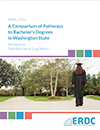To answer this question, we analyzed data housed in the Education Research and Data Center warehouse. This paper is one of the first to explicitly adjust for selection bias while estimating the earnings premium for these pathways. Here are our findings:
- At least during the six years following graduation, workers who went straight into a four year degree program did not earn more than workers who first went to a community college.
- Those who attend a community college before receiving their bachelor's degree earn a little bit more each year (on average) before they graduate than those who go straight into a four year program. This disparity, however, disappears once students graduate.
- Regardless of the path by which workers received their bachelor's degrees, female graudates earn (on average) about 80% of what male graduates earn. A study performed by the U.S. Department of Labor found similar disparities nationwide.


